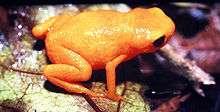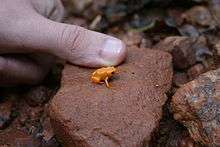Pumpkin toadlet
The pumpkin toadlet (Brachycephalus ephippium), or Spix's saddleback toad, is a small and brightly coloured species of frog in the family Brachycephalidae. This diurnal species is endemic to southeastern Brazil where found among leaf litter on the floor of Atlantic rainforests at an altitude of 200–1,250 m (660–4,100 ft).[2] It is found in Espírito Santo, Rio de Janeiro, southeastern São Paulo and southeastern Minas Gerais. Although its type specimen supposedly was collected in Bahia about 200 years ago, there are no confirmed localities in this state and recent reviews consider it more likely that it was from Rio de Janeiro.[2][3] B. ephippium is locally common,[3] quite widespread compared to most other species of Brachycephalus and it is not considered threatened.[1][2]
| Pumpkin toadlet | |
|---|---|
 | |
 | |
| Close-up (above), size compared to a human thumb (below) | |
| Scientific classification | |
| Kingdom: | Animalia |
| Phylum: | Chordata |
| Class: | Amphibia |
| Order: | Anura |
| Family: | Brachycephalidae |
| Genus: | Brachycephalus |
| Species: | B. ephippium |
| Binomial name | |
| Brachycephalus ephippium (Spix, 1824) | |
B. ephippium feeds on tiny invertebrates and breeding is by direct development, with the female laying a few eggs on land that hatch into young toadlets (no tadpole stage).[4]
Appearance and toxicity

B. ephippium is a very small frog with a snout–to–vent length of 12.5–19.7 mm (0.49–0.78 in) in adults,[5] but it is among the largest in its genus together with species like B. darkside, B. garbeanus and B. margaritatus.[6][7] Females tend to be larger than males.[3] When newly hatched B. ephippium typically measure just 5.25–5.45 mm (0.207–0.215 in).[4]
B. ephippium is overall bright yellow-orange and this is considered aposematic (warning colours) since its skin and organs contain tetrodotoxin and similar toxins.[8] Newly hatched B. ephippium are well-camouflaged and brown overall.[4]
In 2019, scientists discovered that the head and back of this toadlet and the closely related red pumpkin toadlet (B. pitanga) glowed under ultraviolet light, due to their fluorescent skeletons.[9][10] Young that have gained the bright yellow-orange adult colours still lack their fluorescence. It was initially speculated that the fluorescent colour also is aposematic or that it is related to mate choice (species recognition or determining fitness of a potential partner),[10] but later studies indicate that the former explanation is unlikely, as predation attempts on the toadlets appear to be unaffected by the presence/absence of fluorescence.[11]
Call and hearing
Peculiarly, this species and the closely related red pumpkin toadlet are unable to hear the frequency of their own advertising calls, as their ears are underdeveloped. Instead their communication appears to rely on certain movements like the vocal sac that inflates when calling, mouth gaping and waving of their arms.[12][13] It is speculated that their calling is a vestigiality from the ancestral form of the genus, whereas their reduced hearing ability (they do have some hearing ability in frequencies outside their call) is a novel change in these species. Sounds make them more vulnerable to predators, but there has likely been little direct evolutionary pressure to lose it because of their toxicity.[12][13]
See also
- Polka-dot tree frog (Hypsiboas punctatus) — the first frog discovered to be fluorescent, in 2017
References
- Frederico da Rocha, Carlos; Van Sluys, Monique (2008). "The IUCN Red List of Threatened Species". doi:10.2305/iucn.uk.2010-2.rlts.t54453a11149233.en. Cite journal requires
|journal=(help) - Bornschein, M.R.; M.R. Pie; L. Teixeira (2019). "Conservation Status of Brachycephalus Toadlets (Anura: Brachycephalidae) from the Brazilian Atlantic Rainforest". Diversity. 11 (9): 150. doi:10.3390/d11090150.
- Pombal, Jr, J.P.; E.M. Wistuba; M.R. Bornschein (1998). "A New Species of Brachycephalid (Anura) from the Atlantic Rain Forest of Brazil". Journal of Herpetology. 32 (1): 70–74. doi:10.2307/1565481.CS1 maint: multiple names: authors list (link)
- Pombal, Jr., J.P.; I. Sazima; C.F.B. Haddad (1994). "Breeding Behavior of the Pumpkin Toadlet, Brachycephalus ephippium (Brachycephalidae)". Journal of Herpetology. 28 (4): 516-519. doi:10.2307/1564972.CS1 maint: multiple names: authors list (link)
- "Brachycephalus ephippium". Berkeley, California: AmphibiaWeb. 2019. Retrieved 5 February 2020.
- Guimarães, Carla Silva; Luz, Sofia; Rocha, Pedro Carvalho; Feio, Renato Neves (2017). "The dark side of pumpkin toadlet: a new species of Brachycephalus (Anura: Brachycephalidae) from Serra do Brigadeiro, southeastern Brazil". Zootaxa. 4258 (4): 327–344. doi:10.11646/zootaxa.4258.4.2.
- Condez, T.H.; Monteiro, J.P.D.; Comitti, E.J.; Garcia, P.C.A.; Amaral, I.B.; Haddad, C.F.B. (2016). "A new species of flea-toad (Anura: Brachycephalidae) from southern Atlantic Forest, Brazil". Zootaxa. 4083 (1): 40–56. doi:10.11646/zootaxa.4083.1.2. PMID 27394218.
- Pires Jr., O.R.; A. Sebben; E.F. Schwartz; S.W. Largura; C. Bloch Jr.; R.A. Morales; C.A. Schwartz (2002). "Occurrence of tetrodotoxin and its analogues in the Brazilian frog Brachycephalus ephippium (Anura: Brachycephalidae)". Toxicon. 40 (6): 761-766. doi:10.1016/s0041-0101(01)00279-3.
- Fox, Alex (2 April 2019). "Scientists discover a frog with glowing bones". Science. Retrieved 15 April 2019.
- Sandra Goutte; Matthew J. Mason; Marta M. Antoniazzi; Carlos Jared; Didier Merle; Lilian Cazes; Luís Felipe Toledo; Hanane el-Hafci; Stéphane Pallu; Hugues Portier; Stefan Schramm; Pierre Gueriau; Mathieu Thoury (2019). "Intense bone fluorescence reveals hidden patterns in pumpkin toadlets". Scientific Reports. 9: 5388. doi:10.1038/s41598-019-41959-8.
- Rebouças, R.; A.B. Carollo; M.d.O. Freitas; C. Lambertini; R.M. Nogueira dos Santos; L.F. Toledo (2019). "Is the conspicuous dorsal coloration of the Atlantic forest pumpkin toadlets aposematic?". Salamandra. 55 (1): 39-47. doi:10.3390/d11090150.
- Goutte, S.; et al. (2017). "Evidence of auditory insensitivity to vocalization frequencies in two frogs". Scientific Reports. 7: 12121. doi:10.1038/s41598-017-12145-5.
- Supriya, L. (26 September 2017). "These tiny frogs can't hear their own mating songs". ScienceMag. Retrieved 8 February 2020.
